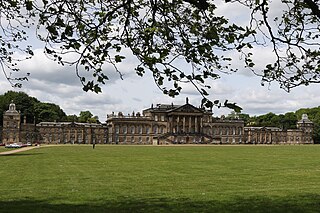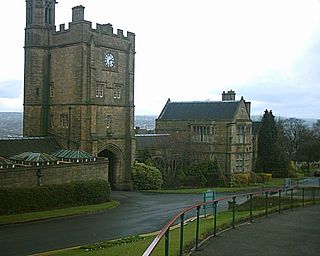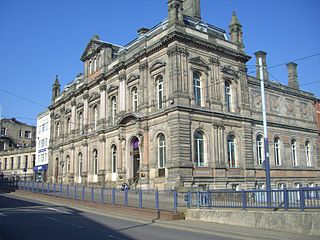
Wentworth Woodhouse is a Grade I listed country house in the village of Wentworth, in the Metropolitan Borough of Rotherham in South Yorkshire, England. It is currently owned by the Wentworth Woodhouse Preservation Trust. The building has more than 300 rooms, with 250,000 square feet (23,000 m2) of floorspace, including 124,600 square feet (11,580 m2) of living area. It covers an area of more than 2.5 acres (1.0 ha), and is surrounded by a 180-acre (73 ha) park, and an estate of 15,000 acres (6,100 ha).

Hathersage is a village and civil parish in the Peak District in Derbyshire, England. It lies slightly to the north of the River Derwent, approximately 10 miles (16.1 km) south-west of Sheffield.

Driffield, also known as Great Driffield, is a market town and civil parish in the East Riding of Yorkshire, England. The civil parish is formed by the town of Driffield and the village of Little Driffield. By road, it is 53 miles (85 km) north-east of Leeds, 29 miles (47 km) east of York and 23 miles (37 km) north of Hull.

Firbeck is a village and civil parish in the Metropolitan Borough of Rotherham in South Yorkshire, England, on the border with Nottinghamshire. It lies between Maltby and Oldcotes, off the A634 and B6463 roads. Firbeck had a population of 317 in 2001, which had fallen to 299 at the 2011 Census.

Birley Spa is a grade-II listed community bath hall and a Victorian bathhouse in the Hackenthorpe district of the City of Sheffield, England.

Woodhouse is a largely residential area just north of the city centre of Leeds and close to the University of Leeds. The area considered as Woodhouse is partly in the Little London and Woodhouse ward and partly in the Headingley & Hyde Park ward of City of Leeds metropolitan district.

The Old Queen's Head is a pub at 14 Pond Hill, Sheffield, South Yorkshire, England. It is a 15th-century timber framed building and the oldest surviving domestic building in Sheffield. It is now Grade II* listed.

Carbrook Hall is a historic house in Sheffield, England. Located in the Carbrook district of the city, the original building was owned by the Blunt family from 1176. This was rebuilt in 1462, and was bought by Thomas Bright in the late 16th century. His descendant, John Bright, was an active Parliamentarian during the English Civil War, and the building was used as a Roundhead meeting place during the siege of Sheffield Castle. The Bright family continued to play a prominent role in Sheffield, however, by the end of the eighteenth century the gentry line had died out. Writing in 1819 Joseph Hunter, a minister and antiquarian from Sheffield wrote "the hall at Carbrook...has been deserted by its owners for more than a century but still retains traces of its former consequence".

The City Road Cemetery is a cemetery in the City of Sheffield, England that opened in May 1881 and was originally Intake Road Cemetery. Covering 100 acres (40 ha) it is the largest and is the head office for all the municipally owned cemeteries in Sheffield. The cemetery contains Sheffield Crematorium, whose first cremation was on 24 April 1905.

Church Fenton is a village and civil parish in the North Yorkshire district of North Yorkshire, England. It is about 16 miles (26 km) east of Leeds, about 6 miles (10 km) south-east from Tadcaster and 3 miles (5 km) north from Sherburn in Elmet. Neighbouring villages include Barkston Ash, Cawood and Ulleskelf. The former RAF Church Fenton is located immediately north-east, which is now known as Leeds East Airport.

Dungworth is a hamlet in the civil parish of Bradfield, west of Sheffield in South Yorkshire, England.

Shire Brook is a small stream in the south eastern part of the City of Sheffield in South Yorkshire, England. It rises in the suburb of Gleadless Townend and flows in a general easterly direction for 4 miles (6.5 km) to its confluence with the River Rother between Beighton and Woodhouse Mill. In the past the brook has been both the border of Yorkshire and Derbyshire and between the sees of Canterbury and York. The course of the stream has been influenced by human intervention in the 20th century with the brook being diverted underground and flowing through culverts on three occasions as it traverses locations which were formerly landfill sites and extensive railway sidings.

Hallfield House is a Grade II listed building situated in Bradfield Dale, 1.7 miles (2.74 km) west of the village of Low Bradfield, near Sheffield in England.

Mount Pleasant is an 18th-century mansion situated on Sharrow Lane in the Highfield area of the City of Sheffield in South Yorkshire, England. The house stands just under two km south of the city centre and is a grade II* listed building, it has been described as "one of the best 18th century houses in Sheffield". The adjacent former stables and coach house are also Grade II* listed.

Canada House, formerly known as Panache House, is a Grade II* listed building situated on the northern side of Commercial Street in the centre of the city of Sheffield, South Yorkshire, England. It was built as the head offices of the Sheffield United Gas Light Company in 1874. While the main outlook of the building is out onto Commercial Street there is also a short frontage onto Shude Hill at its eastern end and this designated as 19 Shude Hill.

The Yorkshire Grey was a common name for public houses in England, some still survive but most have now closed or changed their name. They were named for the Yorkshire Grey Horse, a breed commonly used to pull brewery drays.

Greenside House is an 18th-century residence located in Hackenthorpe, Sheffield, England. The building is estimated to have been built around 1825 and is a Grade II listed building.

Thomas Staniforth & Co. was a sickle, scythe and tool smiths based in Hackenthorpe, Sheffield, England. The company was founded by Thomas Staniforth in 1743 and operated out of workshops located on Main Street, Hackenthorpe until it was closed during the 1980s and its assets incorporated into Spear & Jackson. The company was known for its Severquick brand of gardening tools.

The Herdings is a grade-II listed building located in Herdings, Gleadless Valley, Sheffield, England. Although the current structure dates back to 1675, the original Herdings farm building was recorded as being present as early as the 13th-century.

The Golden Beam is a pub and Grade II listed building located in the Headingley area of Leeds, West Yorkshire, England. It was built in c. 1912 for the Church of Christ, Scientist, and was known as the Elinor Lupton Centre from 1986 to 2010 when it was a school arts centre. It was designed by Piet de Jong and William Peel Schofield from the architectural firm Schofield and Berry. Constructed in white Portland stone in a mixed style of Egyptian Revival and Art Deco, it was originally built as a Sunday school in c. 1912–1914, extended in the 1930s with a church building and then used by the Leeds Girls' High School as a theatre and music centre from 1986 until 2010. The structure has architectural significance in the locality due to its distinct style and use of materials; many original features and fittings survive, including the entrance foyer, two staircases and a glazed lantern in the auditorium roof.




















